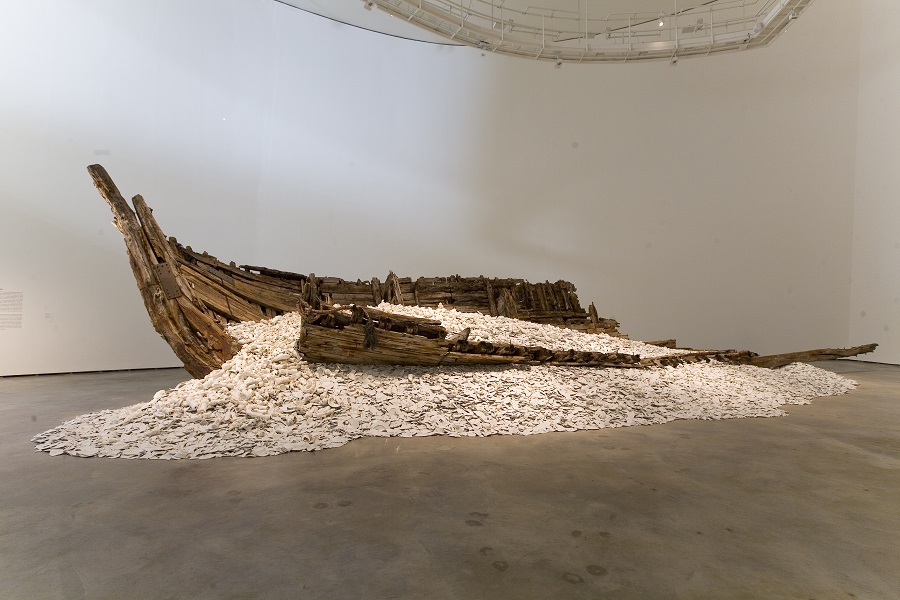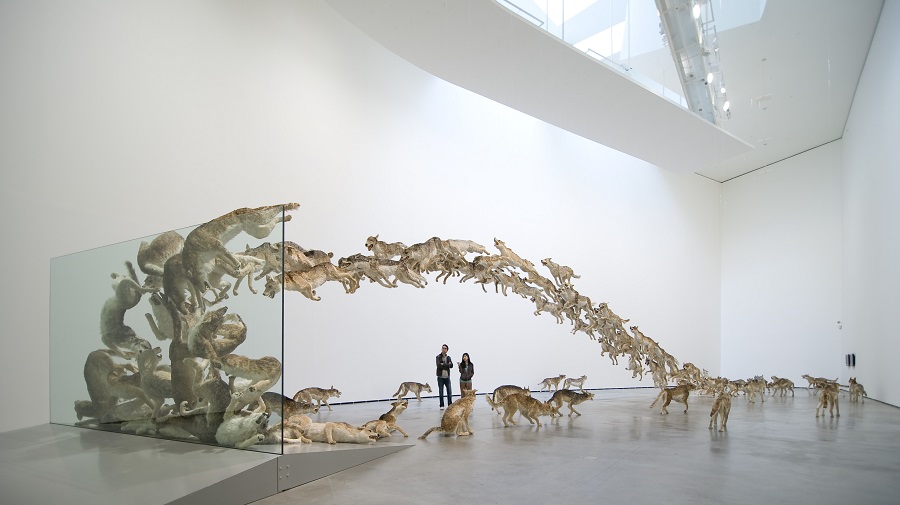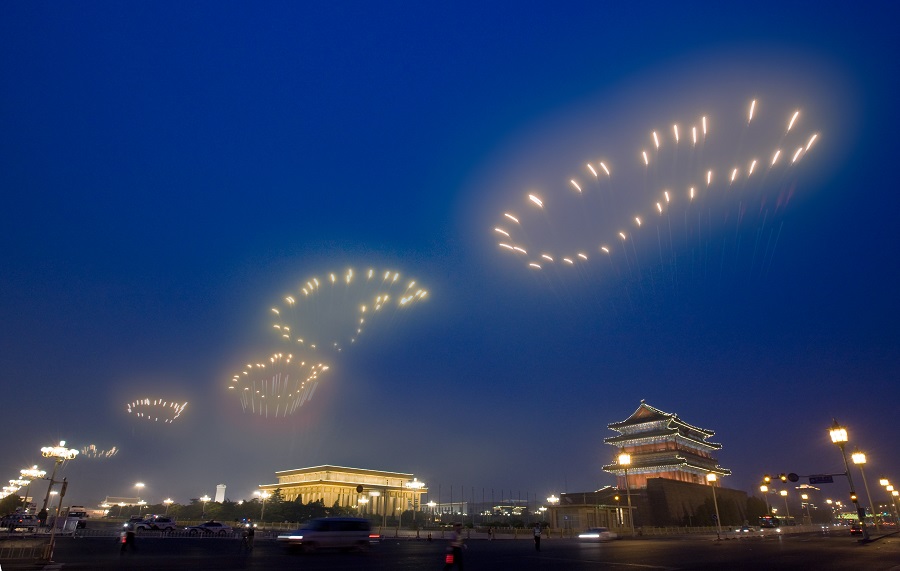One morning in May we arrived at the appartment that Cai shares with Hong Hong Wu, his wife, and their two daughters in New York's Soho district. As he was refurbishing his work studio at the time, we were lucky enough to see his home transformed into a kind of workshop, complete with some of his works lying around on furniture and on the floor. We enjoyed an unforgettable leisurely lunch with the Cai family and some friends, which gave us a great opportunity to observe the artist in his natural habitat: his rhythm, his look, his profound love of music and above all, his way of communicating. Cai Guo-Qiang can be described as one of the world’s most recognized Chinese artists. He was born in 1957 in Quanzhou City, Fujian Province, China, a city known for its cultural openness and religious diversity, due in no small part to its coastal location.
Author: Elena Cué

Cai Guo-Qiang observing one of the sculptures in the Patio during the exhibition I Want to Believe at Bilbao's Guggenheim Museum, 2009
One morning in May we arrived at the appartment that Cai shares with Hong Hong Wu, his wife, and their two daughters in New York's Soho district. As he was refurbishing his work studio at the time, we were lucky enough to see his home transformed into a kind of workshop, complete with some of his works lying around on furniture and on the floor. We enjoyed an unforgettable leisurely lunch with the Cai family and some friends, which gave us a great opportunity to observe the artist in his natural habitat: his rhythm, his look, his profound love of music and above all, his way of communicating.
Cai Guo-Qiang can be described as one of the world’s most recognized Chinese artists. He was born in 1957 in Quanzhou City, Fujian Province, China, a city known for its cultural openness and religious diversity, due in no small part to its coastal location. He moved to New York in 1995, where he began producing, social- and cultural-themed works, but it wasn’t until the end of that decade, coinciding with the sudden breakthrough of Chinese art in the rest of the world due to broader Chinese reform and change within the country, that his work began to be exhibited in the US.
His decision to relocate from East to West has also instilled in him a greater interest in bringing the two cultures closer together. He is passionate about Taoist cosmology, and thus finds himself in a permanent state of profound movement and change. As a conceptual artist, his work recovers cultural memory —via installations, ephemeral ‘explosion events’ and drawings made with gunpowder— in order to tackle ideological issues and historical conflicts with a poetic aesthetic approach. His hometown and cultural roots are always present in his work, evoking an eternal return to a world of nature and spirituality, and a conduit between the world of the visible and the invisible. A recurring theme underpinning Cai’s art is in fact the desire to unite these two worlds; his artworks skillfully and playfully juggle space and time, tradition and contemporaneity, blurring the existing social and cultural limits of any culture, ripping one out of its context and placing it in another to create a new global whole.

Cai Guo-Qiang in front of Odyssey, the permanent installation at the The Museum of Fine Arts, Houston, 2010. Photograph by I-Hua Lee, courtesy of Cai Studio
Youth
His youth coincided with a time of great upheaval and radicalization in China, the decade between 1966 and 1976 (the Great Proletarian Cultural Revolution).
Elena Cué: How has the spiritual influence of that kind of upbringing–growing up in an era where the Chinese Communist Party was undergoing a process of ideological affirmation– affected the artist you are today?
Cai Guo-Qiang:The political movements during the Cultural Revolution employed tactics that motivated large crowds. Having witnessed and even taken part in some of the parades during that period, I later applied the same strategies to my art practice. For instance, I often work with large groups of volunteers from local communities to realize my artworks. My goals may be different from the political leaders’, and the ways in which I work with large groups of people may also be different, but it is evident that I am influenced by these experiences from my youth. People of my generation were taught [by Chairman Mao], “to rebel is justified”, and we were told to disregard figures of authority. As a contemporary artist, this gave me the courage to step away from tradition, explore new mediums and new ways of working, and to transform traditional iconographies with my own visual language.

Shining and Solitude, 2010. Gunpowder on paper, vulcanic rock, and 9,000 litres of mescal. From artist's own collection. View of the installation at the Museo Universitario Arte Contemporáneo, UNAM, Mexico City, 2010. Photograph by Diego Berruecos, courtesy of MUAC
Cai studied stage design at the Shanghai Theatre Academy, and he tried his hand at cinema by participating in two martial arts films. He also dabbled in violin and theatre, and has a wonderful voice that I personally have had the pleasure of hearing. His father, a traditional painter and calligrapher, would paint landscapes on matchboxes, and was a great influence on the artist. “A small space can easily be filled with the corners of the earth”.
E.C: How have all these experiences shaped the person you are today?
C.G.Q: At the Shanghai Theater Academy, the training I received in stage design was different from the art academies at the time. I learned many different approaches to come up with creative ideas: from working freely with different materials, to studying spatial compositions, and these help me create diverse forms of art. The collaborative team spirit and the performance aspect, the emphasis on dramatic effects, the focus on audience interaction or participation in theater, and the temporal nature in artistic expression—all helped shape characteristics of my work.

Refection–A gift from Iwaki, 2004. Remains of a shipwreck and porcelain piece. Size of the boat: 5 x 5.5 x 15 m. Faurschou Collection. View of the installation at the Guggenheim Museum in Bilbao, 2009. Photograph by I-Hua Lee, courtesy C
E.C: In 2008 the Guggenheim Museum organized your retrospective Cai Guo-Qiang: Quiero Creer (I Want to Believe), this exhibition was presented in New York, Beijing and Bilbao, and featured works spanning over two decades of your art production. What does Cai Guo-Qiang want to believe in?
C.G.Q: I Want to Believe is a comprehensive examination of my early works, many of which express a deep-seated curiosity towards the universe and the unseen worlds around us. The exhibition title therefore encompasses all these possibilities, whether they are extraterrestrials, principles of feng shui and Chinese medicine, or metaphysical forces and worlds not visible to the human eye. It expresses an attitude and a sense of anticipation.

Head On, 2006. 99 life-size wolf models and glass wall. Wolves: muslin, resin and skins, various sizes. Deutsche Bank Collection. View of the installation at the Guggenheim Museum in Bilbao, 2009. Photograph ©FMGB Guggenheim Bilbao Museoa, 2009 (Erika Barahona-Ede)
A critical view of mass ideologies is present in Cai’s work, a famous example of which can be seen in the piece Head On, where 99 life-size wolves form a large suspended arch before crashing head-first into a glass wall. The work references the legacy of Nazism on contemporary Germany and that of the Cold War, evidencing the impossibility of learning from our own mistakes (the wolves return to the beginning, starting the cycle once again).
Even works such as Head On, with their solid conceptual baggage, or when dealing with more violent or disturbing subjects, Cai’s works achieve an elegant aesthetic expression: there is harmony in their design and beauty in their form. The artist’s own philosophy is always expressed in an aesthetically pleasing, poetic form.
E.C: What meaning do you ascribe to the Plautus’ phrase “Man is man’s wolf”, popularized by philosopher Thomas Hobbes?
C.G.Q: Growing up, I saw how figurative paintings depicting human subjects—either political leaders or soldiers at war—were used as tools for propaganda, and have thus avoided portraying people in my work. To tell stories, I often use animals as a metaphor for human behaviour. Animals are more natural, more spontaneously expressive than humans, and they can be more easily integrated into exhibition spaces and themes.

Bringing to Venice what Marco Polo Forgot, 1995. Installation which includes a wooden fishing boat from Quanzhou, Chinese herbs, ginseng (100 kg) and other works by the artist. Commissioned by the 46th Venice Biennale. From the Museo Navale di Venezia's collection and private collections. View of the arrival of the boat in Venice. Photo by Yamamoto Tadasu, courtesy of Cai Studio
In 1995, at the 46th Venice Biennale, Cai presented Bringing to Venice what Marco Polo Forgot.
E.C: With your 1995 installation for the Venice Biennale, what did you bring to Venice that Marco Polo had forgotten?
C.G.Q: The year 1995 marked the 700th anniversary of Marco Polo's return to Venice from China after a maritime journey that began in Quanzhou, my hometown, so I decided to make a joke about Marco Polo. He brought back many stories of the East to the West, but he did not tell the West about Eastern thought and philosophy, so I sought to remedy this oversight by bringing Chinese herbal medicine from the East to the West. I brought an old-fashioned fishing boat brought from Quanzhou, and navigated it along Venice's Grand Canal from Piazza San Marco to Palazzo Giustinian Lolin.
The boat docked outside the palazzo, and functioned as a seating area where visitors could savor the medicinal tonics and potions offered inside. Within the palazzo, a modern vending machine was installed on one wall to dispense five varieties of bottled herbal tonics for 10,000 lira each. These drinks were formulated according to the ancient Chinese principle of “five elements,” wherein the five elements of natural phenomena (wood, fire, earth, metal, water) correspond to five tastes (bitter, sweet, sour, spicy, salty) and five organs of the human body (liver, heart, spleen, lung, kidney). The prescriptions posted on one wall enabled participants to select remedies suitable to their needs.
Available along the opposite wall were traditional ginseng soup and ginseng liquor, each contained in a large earthen jar. Visitors used bamboo ladles to pour these potions—formulated to enhance bodily qi, or energy—into porcelain cups.
To commemorate the 100th anniversary of the Venice Biennale, 100 kilo sacks of ginseng were displayed on a handcart placed near the ginseng service. I applied the idea of healing a living organism and its energy flows to the city and its canals. Inside the entrance of the palazzo, I hung a plastic curtain that was filled with canal water and covered with common acupuncture meridian charts, and symbolically pierced it with acupuncture needles.

Legacy, 2013. 99 life-size animal reproductions, water, sand, dripping mechanism, various sizes. Collection of Queensland Art Gallery | Gallery of Modern Art. View of the installation at the Gallery of Modern Art, Brisbane, 2013. Photography by Queensland Art Gallery ׀ Gallery of Modern Art
In 1966, in the first days of the Cultural Revolution, the People’s Liberation Army decided to create a portrait on the mountainside by carving it out in the rock — what Cai describes as his first contact with Land Art. This relationship between man and nature is very present in Cai’s work, something he reflects on in his latest exhibition, Falling Back to Earth, his first solo exhibition at the Gallery of Modern Art in Queensland, Australia.
E.C: Does this fall back to Earth symbolize a need to return back to your roots, to nature?
C.G.Q: The title of the exhibition Falling Back to Earth conjures a sense of yearning for the spirit expressed in Chinese literati paintings of earlier times, when people lived humbly and in harmony with nature, an ideal that stands in opposition to the way in which people interact with nature now.

The Ninth Wave, 2014. The installation includes 99 life-size animal reproductions, wooden fishing boat, white flag, electric fan. Size of the boat: 17x 4.55 x 5.8 m. From artist's own collection. Commissioned by the Power Station of Art, Shanghai. View of The Ninth Wave navigating across the Huangpu River near Bund, Shanghai, 2014. Photography by Wen-You Cai, courtesy of Cai Studio
The ecological and environmental crisis that China is suffering is at the heart of his latest exhibition, The Ninth Wave. It is also the first solo exhibition of a living artist at the Shanghai Power Station of Art. In it, an apocalyptic Noah's Ark - a fishing boat full of dying artificial animals - navigates the Huangpu River as a symbol of the dangerous present-day situation. It is also a recognition of the need to return to nautre and to our spiritual roots.
E.C: Do you believe that Art should serve a moral, social, political, or cultural end... Or should art be the act of expressing our unguarded passion?
C.Q.G: There are many types of artists, and there are no hard and fast rules on how artists should act and behave. Otherwise art will turn into history and become static, rather than constantly improving and changing with the times.

History's footprints: Fireworks project for the opening ceremony of the Olympic Games in Beijing, 2008. The display took place in Beijing on August 8, 2008. Commissioned by The International Olympic Committee and The Beijing Organizing Committee for the Games of the XXIX Olympiad.
Photograph by Hiro Ihara, courtesy of Cai Studio
He lived in Japan between 1986 and 1995, where he got to know and use gunpowder as a tool for art, and which eventually became the art form for which he is globally known. Gunpowder has become an artistic creative source that defines his identity as an artist; this powerful material has been used by the artist as transformative energy to create drawings and ‘explosion events’.
His work includes a number of dichotomies: a mixture of traditional symbols — acupuncture, dragons, powder — and contemporary ones (time), a merging of East and West (space), and the contrast between yin and yang, destruction and creation (opposing forces).
E.C: Your interest in time and space, opposite forces and cosmology are evident in your work. What is your guiding philosophy in life?
C.G.Q: In the I Ching, or the Book of Changes, “I” means “change”, and this is important. There are also two doctrines I embrace in Daoist philosophy: “no law is the law”, and “leveraging others’ power to exert your own strength”. In Confucianism, tolerance is a value that has taught me not to exclude others, and to learn from and work with people of different cultures; it enables me to find new possibilities in art. These underlying principles are the most valuable lessons I have learned from Eastern philosophy, and they are more important to me than superficial symbols (such as dragons), or even gunpowder as a choice of artistic medium.

Tree with Yellow Blossoms. Photo by I-Hua Lee, courtesy Cai Studio
Authorized copy to Alejandra de Argos of article originally published by ABC
- Interview with Cai Guo-Qiang - - Home: Alejandra de Argos -



